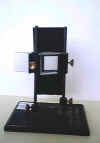
 SM173
Weinhold Apparatus circa 1960
Light
SM173
Weinhold Apparatus circa 1960
Light
A prism has both a refractive power and a dispersive power and these are
not proportional but depend on the material of the glass forming the
prism.
Dense flint glass has a high dispersive power.
So, in combination with crown glass of lower dispersive power an
achromatic combination can be produced which gives refraction while the
dispersion is neutralised.
This combination comprises a crown glass prism of angle 45
degrees combined with a flint glass prism of angle 23 degrees.
The prisms are combined so as to be in opposition.
Another combination possible is a 23 degree flint prism with a 27 degree
crown prism.
Here the refractive powers are neutralised while dispersion of
the undeviated beam occurs.
These combinations can be examined in an apparatus devised by Professor
Weinhold which consists of a stand with two supporting rods.
One rod holds two crown glass prisms of angles about 27 degrees
and 45 degrees.
The other rod holds an approximately 23 degree flint prism.
Two black screens serve to cut off the unwanted part of a beam of
light.
The prisms and screens are adjustable in height so that one half
of a prism can be used in comparative experiments.

![]()
 Museum
Museum
![]()
 SM173
Weinhold Apparatus circa 1960
Light
SM173
Weinhold Apparatus circa 1960
Light
![]()